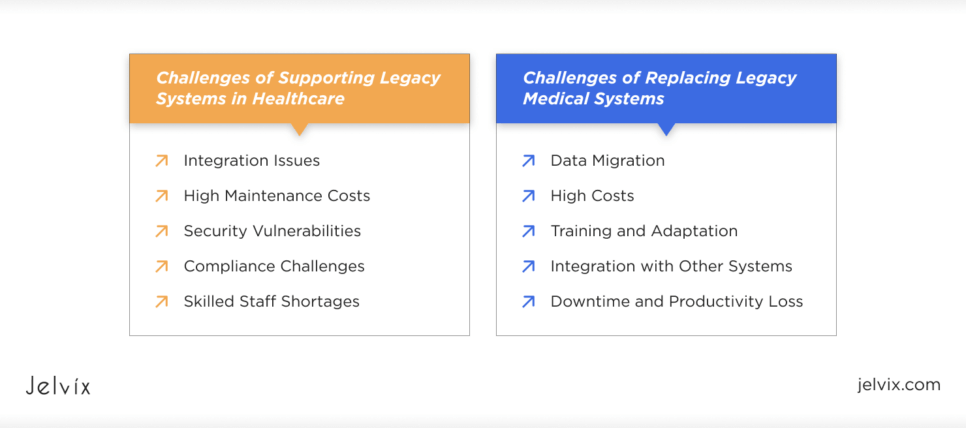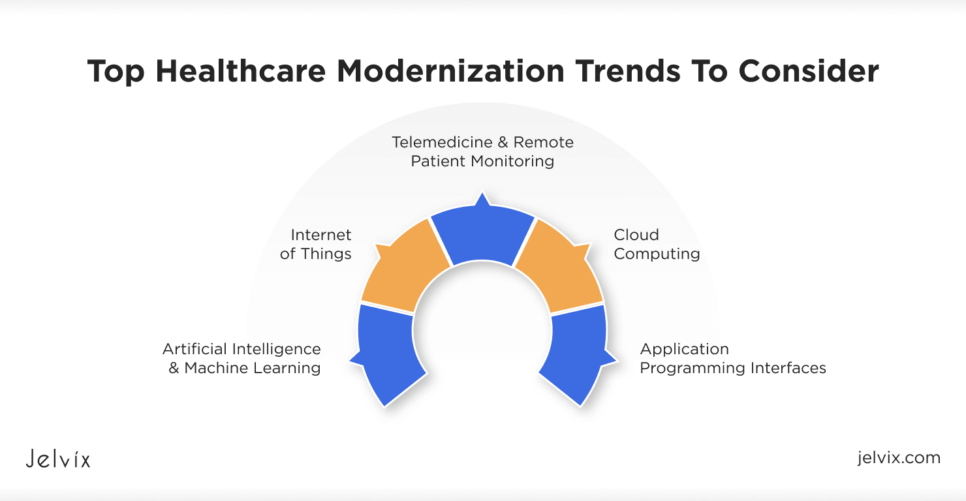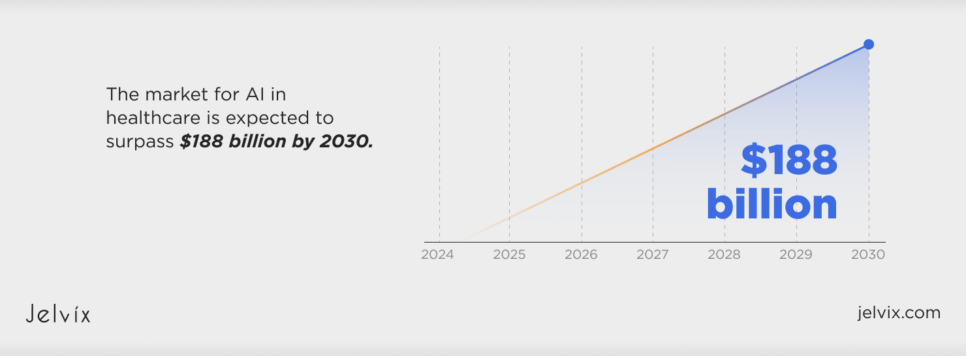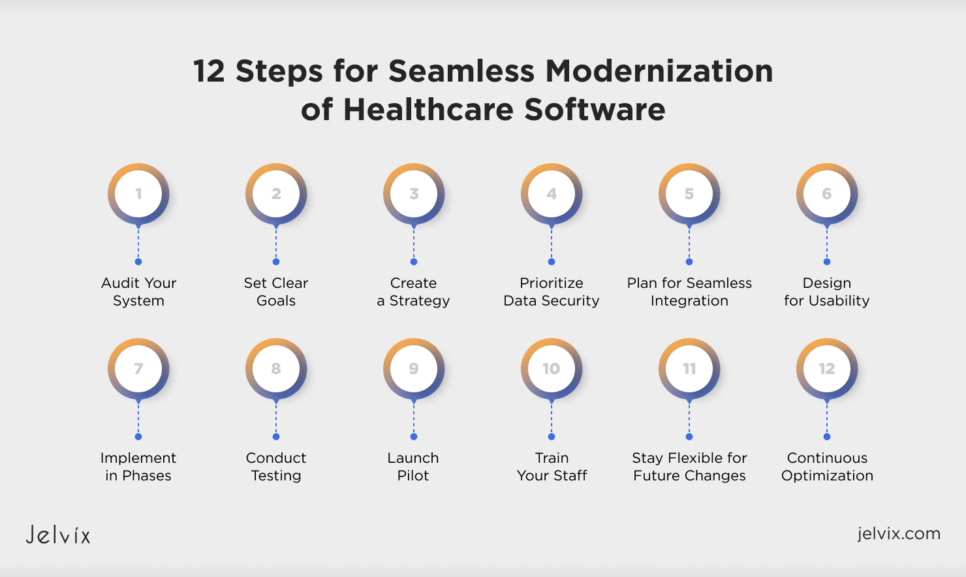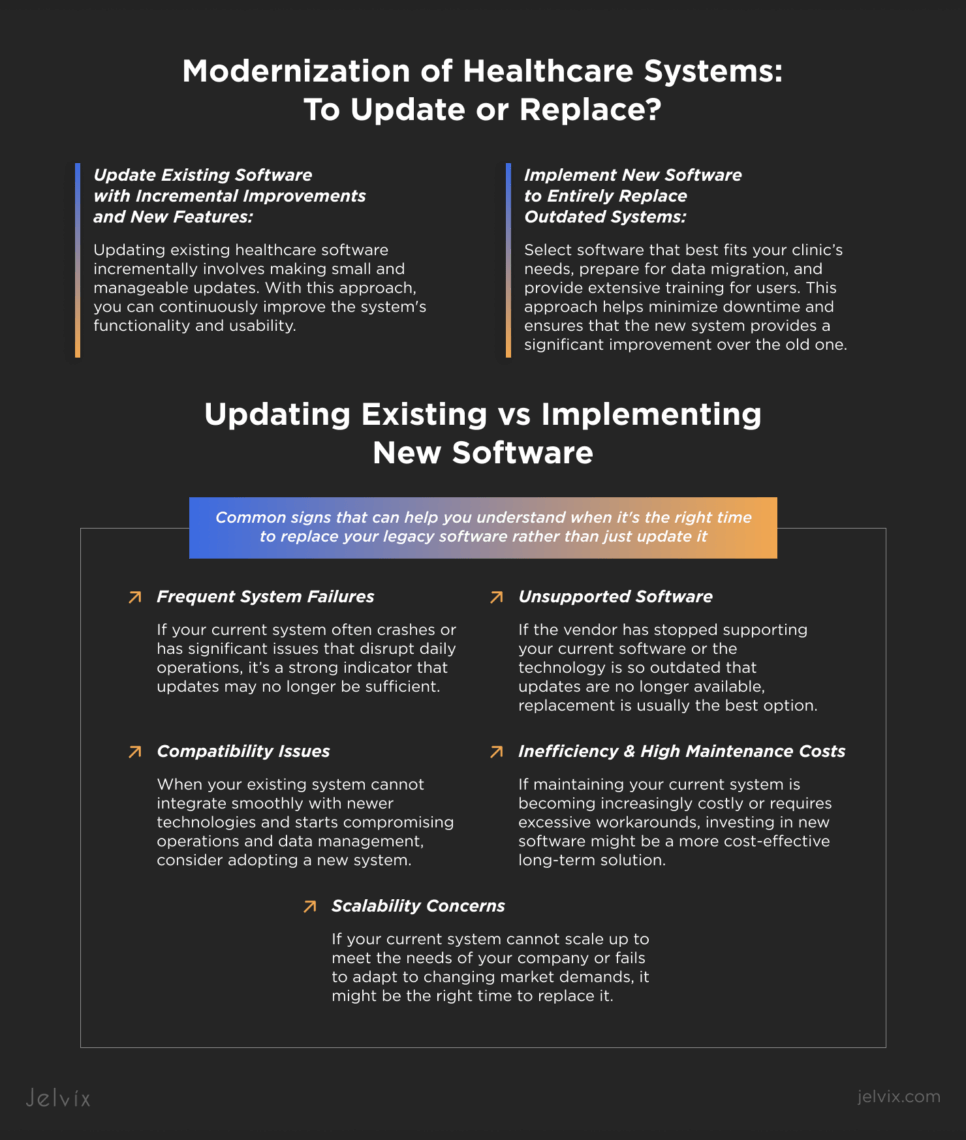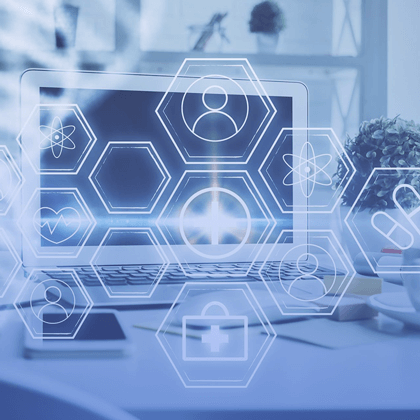Despite technical advancements in healthcare, about 73% of medical companies work with outdated software. While legacy systems might feel easy and familiar to use, they slow down clinical processes, can’t guarantee to protect patient data, and fail to keep up with industry regulations.
The big question for many clinics is whether to modernize current systems or start fresh with new ones. The decision is challenging and requires numerous factors to be considered.
If you aim to keep up with the latest medical tech trends but are unsure what to do with your software, read this article. You’ll find out the key criteria for modernizing your clinical system, learn proven strategies to make the process painless, and discover key steps for a successful modernization.
Signs That Your Clinic Needs Legacy Software Modernization
Upgrading your medical software means ensuring that the care you deliver stays efficient and secure. Spotting key signs for modernization early on can prevent your clinic from setbacks and disruptions and can also save you costs.
Limited Healthcare Software Functionality
Modern healthcare software development demands flexibility and robust functionality that older systems often fail to provide. If your current software can’t keep up with the tasks it’s supposed to manage or lacks features that are standard in newer systems, it’s a primary sign for an upgrade. This limitation can compromise your staff’s productivity and affect the quality of patient care.
Malfunctions and Tech Incompetence
Frequent system crashes, slow performance, and errors in data handling can cause critical mistakes in your clinical operations and negatively impact patient care. When your software starts to fail regularly, risking data integrity and slowing down daily operations, it’s a signal that your current system is no longer reliable and requires modernization.
End of Vendor Support
A very clear indicator that it’s time to modernize is when your software vendor announces the end of support for your system. Without ongoing updates and support, your system will become vulnerable to security risks and compatibility issues, making the integration of new features impossible.
Some additional indicators may include increased operational costs due to inefficiencies, compliance issues with new regulations, and poor user feedback from patients and staff. Whenever you notice any of these, consider checking out the efficiency of your current systems and possibly get prepared for modernization.
Challenges of Supporting Legacy Systems in Healthcare
Sticking to a legacy EHR can impose risks that far outweigh the costs and challenges of modernization. In contrast, addressing key challenges of legacy system support can lead to improved efficiency, better security, and a stronger foundation for future technological advancements across your medical entity.
Integration Issues
Legacy software systems don’t always work well with new technology. This can lead to data silos, making it tough to take care of patients and analyze data efficiently. Consider implementing middleware, which acts like a bridge making it easier for the old and new systems to talk to each other. You can also opt for modular updates, which lets you add new tech slowly without changing everything at once.
High Maintenance Costs
Older systems usually get more expensive to keep running as they age. These costs can increase a lot, especially when hardware or software is no longer supported by vendors. The Jelvix team suggests moving to cloud-based services for convenience. This can cut down on the need for expensive on-site hardware maintenance and upgrades. What’s more, cloud services often come with vendor support, reducing internal resource requirements.
Security Vulnerabilities
Legacy systems may not comply with the latest security standards, making them susceptible to breaches. For instance, about 364,571 healthcare records were breached every day in 2023. To prevent such outcomes, regularly update cybersecurity measures across your clinic and apply patches to protect against known vulnerabilities. If updates are no longer available, employ additional security layers, such as advanced firewalls and intrusion detection systems.
Compliance Challenges
Healthcare laws keep changing to better protect patient privacy and improve how clinics handle their data. Older systems often struggle to keep up with new rules, which can lead to compliance issues. A good way to manage this is by working with legal experts. They can guide you in setting up the best practices and extra controls to make sure your systems follow the current healthcare regulations properly.
Limited Functionality
Over time, the needs of healthcare entities and patients change. Legacy systems may lack the flexibility to adopt new functionalities or improve user experiences for better patient satisfaction.
Assess the feasibility of adding new features through third-party applications that can integrate with your legacy system. If critical functionality is missing, prioritize these areas during a gradual system upgrade.
Skilled Staff Shortages
Experienced professionals can feel overwhelmed with maintaining older systems that don’t perform as needed. It can be hard to find people who know how to work with old systems. You can develop training programs to upskill current staff to manage legacy software. Alternatively, you can outsource the maintenance to experts who can manage legacy systems more efficiently.
Dealing with these problems can help keep your old healthcare software going while you plan for a newer and better system. This way, physicians and executives can keep doing their jobs well without significant tech troubles.
Challenges of Replacing Legacy Medical Systems
Although replacing legacy systems can be truly beneficial for your clinic, there are challenges that you shouldn’t ignore. Addressing them before you go into full system replacement will help you make the process smooth and cost-effective.
High Costs
Putting a new system into work is a costly decision. Not only do you have to pay for the software, but there might also be costs for new equipment, setting everything up, and making sure it fits your clinic’s needs. To prevent unexpected expenses, plan the budget carefully. Ask your software vendors whether they offer financing solutions or staggered payment plans to help spread out the costs
Data Migration
Moving patient data from the old system to a new one can be complex and risky. The data can be lost or messed up during the migration process, which can lead to significant issues with patient care and compliance. Use data migration tools that can automate much of the process. Also, hire data migration experts who know how to handle migration efficiently.
Training and Adaptation
Staff may need detailed training to adapt to the new system, which is time-consuming. What’s more, this can disrupt established operations and lead to resistance among users accustomed to the old system. Consider ongoing support and training sessions to help users get comfortable and proficient with the new system.
Integration with Other Systems
New systems must be compatible with other technology in use. Ensuring seamless integration can be challenging and may require additional time and resources. Choose new systems that are known for their compatibility with other healthcare tech and use middleware to help different systems communicate effectively.
Downtime and Productivity Loss
The process of replacing a legacy system can lead to downtime, which may impact service delivery and operational productivity. You’ll need to manage this downtime carefully to minimize the disruption. Plan the transition ahead to minimize the downtime. Also, choose times when the system is least active for major updates or changes.
Key Strategies for Modernizing Legacy Systems in Medical Settings
Modernizing legacy healthcare software is what clinics should do to keep up with technology trends and improve their services. There are proven strategies that healthcare organizations can follow to update their old systems.
Update Existing Software with Incremental Improvements and New Features
Updating existing healthcare software incrementally involves making small and manageable updates. By adding new features or improving existing ones step-by-step, you can minimize disruptions to daily operations. With this approach, you can continuously improve the system’s functionality and usability. This ensures the system is able to meet current legal standards and user expectations without a complete overhaul.
If you want to enhance your system’s reliability, maintaining ongoing support and training for the updated software can be a good idea. This way, all users will be updated with the new features and able to use the system effectively.
Implement New Software to Entirely Replace Outdated Systems
When legacy systems are no longer viable for an update, it’s time to replace them with new software. This approach involves a complete overhaul of the existing system with an opportunity to adopt the latest tech that is more efficient, secure, and easier to maintain.
Implementing a new system requires careful planning to ensure a smooth transition. Select software that best fits your clinic’s needs, prepare for data migration, and provide extensive training for users. This approach helps minimize downtime and ensures that the new system provides a significant improvement over the old one.
Updating Existing vs Implementing New Software
Both strategies have their pros and cons, and you have to think about what your clinic needs, what you can afford, and what will help the most in the long run. Updating might be easier and cheaper now, but getting new software could be better in the long run.
There are common signs that can help you understand when it’s the right time to replace your legacy software rather than just update it.
Frequent System Failures
If your current system often crashes or has significant issues that disrupt daily operations, it’s a strong indicator that updates may no longer be sufficient.
Unsupported Software
If the vendor has stopped supporting your current software or the technology is so outdated that updates are no longer available, replacement is usually the best option.
Compatibility Issues
When your existing system cannot integrate smoothly with newer technologies and starts compromising operations and data management, consider adopting a new system.
Inefficiency and High Maintenance Costs
If maintaining your current system is becoming increasingly costly or requires excessive workarounds, investing in new software might be a more cost-effective long-term solution.
Scalability Concerns
If your current system cannot scale up to meet the needs of your company or fails to adapt to changing market demands, it might be the right time to replace it.
Top Healthcare Modernization Trends To Consider
Healthcare technology develops all the time helping doctors take care of patients better and make the work easier for everyone. In the near future, we can expect several trends that will move your software modernization efforts to the next level.
Telemedicine and Remote Patient Monitoring
Many clinics aim to integrate telemedicine and RPM, including chronic disease management software, into their settings. Since this tech allows doctors to track health conditions remotely, clinics can offer more accessible medical services, boosting patient satisfaction.
Cloud Computing
More healthcare organizations are moving their data and applications to the cloud. Cloud providers like Amazon Web Services allow for better data management, scalability, and accessibility without the need to maintain costly physical servers.
Artificial Intelligence and Machine Learning
The market for AI in healthcare is expected to surpass $188 billion by 2030. AI and ML owe this popularity to their ability to provide predictive analytics, enhance diagnostic accuracy, and automate administrative tasks. They also help doctors figure out what’s wrong with patients quicker and more accurately and make timely interventions for their health.
Application Programming Interfaces
APIs let different computer systems talk to each other smoothly, supporting interoperability. They enable seamless data exchange and integration, allowing diverse healthcare applications and systems to communicate effectively, which is vital for patient care and multi-platform data access.
Internet of Things
IoT devices are transforming patient care by providing real-time data directly from medical devices like heart monitors straight to physicians. This means doctors can keep an eye on their patients without making them visit the clinic all the time.
As you can see, these trends are mostly aimed at personalized care and convenient access to it. If you want to do a better job at looking after patients and making sure everyone gets the best care possible, you need to consider modernizing your legacy systems.
12 Steps for Seamless Modernization of Healthcare Software
Successful modernization of your healthcare software requires a structured approach. This will ensure the new system meets your clinic’s needs while enhancing performance and security. The Jelvix team recommends that you follow a step-by-step approach for seamless modernization.
1. Audit Your System
Begin by conducting a review of your current software. Identify which parts are outdated, what’s working well, and which processes could benefit from new technology. This initial audit will help identify areas where improvements can make the best impact.
2. Set Clear Goals
Define specific and measurable objectives for your modernization project. Whether it’s reducing operational costs, improving patient outcomes, or ensuring data compliance, having clear goals will guide the process and help quantify the success of your modernization efforts.
3. Create a Strategy
Develop a detailed plan that outlines how exactly you will achieve your modernization goals. This strategy should help you decide whether to update existing systems or replace them entirely, which technologies to implement, and how these changes will align with your organization’s objectives.
4. Prioritize Data Security
Sensitive healthcare data requires strong security. Upgrade your cybersecurity measures to protect patient info against data breaches and ensure compliance with healthcare regulations. This may include advanced encryption algorithms like AES and RSA, multi-factor authentication, role-based access controls, and continuous security monitoring.
5. Plan for Seamless Integration
Ensure that the new software can integrate smoothly with existing systems. This involves compatibility checks and possibly updating some of your current infrastructure to support the new software. You need effective integration to minimize disruptions during the transition.
6. Design for Usability
Focus on creating an intuitive user experience that adheres to accessibility standards like the Web Content Accessibility Guidelines. An easy-to-use interface will help increase adoption rates, reducing resistance to the new system.
7. Implement in Phases
Break the modernization project into smaller phases. This approach allows for adjustments based on feedback and helps reduce the risks of process disruptions. It also provides opportunities for quick wins that can support the project.
8. Conduct Testing
Perform extensive testing of the new system to ensure all functionalities work as intended. This should include functional and non-functional testing to cover all aspects of the software’s performance and security.
9. Launch Pilot
Before going full-scale, consider starting with a pilot launch. Try out the new software in a small part of your clinic first. This test run will help fix any problems early and make sure everything works right before your clinic starts using it extensively. This way, if something goes wrong, it won’t mess up critical processes.
10. Train Your Staff
Assess if your current staff has the necessary skills to operate the new system. Provide training sessions, detailed documentation, and ongoing support to bridge the skill gaps. This way you’ll ensure that your team can fully use the new software once it goes live.
11. Stay Flexible for Future Changes
Design your new system with flexibility in mind to easily implement future advancements. This forward-thinking approach ensures your software remains relevant and can adapt to future trends without requiring another major overhaul.
12. Continuous Optimization
After the software goes live, continuously monitor its performance and gather user feedback. Use this information to make improvements and ensure the system remains efficient and continues to meet the needs of your clinic.
Useful Tips for Successful Legacy System Modernization
Modernizing healthcare systems is a complex job that involves understanding the tech and legal aspects of the process. You can follow a few tips that will help you navigate the challenges of modernizing your software without causing disruptions in current processes.
Engage Stakeholders
Communicate with those who will use your system early on, including medical professionals, IT staff, and administrative personnel. Their ideas and needs can help ensure the new system works well and makes the jobs of all stakeholders easier and more efficient.
Be Ready for the Unexpected
Always have a contingency plan in place for unexpected challenges. Regular backups and a solid rollback plan can save you time and resources in case something goes wrong.
Choose the Right Strategy
Figure out the best way to modernize your system. This might mean moving it to a new platform, making changes to the existing setup, or starting over with something completely new. Think about what your clinic needs, your budget constraints, and your plans for the future.
Monitor and Iterate
After the implementation, continuously monitor the system’s performance and collect user feedback. Use this information to make iterative improvements. This will help ensure the system continues to meet your company’s needs effectively.
Partner with Reliable Vendors
Choose healthcare technology partners who know a lot about modernizing legacy healthcare systems. A good partner will guide you through the process, giving you useful advice and supporting your efforts after everything is set up.
Navigate the complex process of choosing a health tech partner with Jelvix's comprehensive guide. Find essential criteria and expert insights for successful collaborations in healthcare.
How Jelvix Can Help Modernize Legacy Healthcare Systems
Updating old healthcare systems is a big step towards using the latest digital tools and medical technology. While this update can seem costly, it can save you money in the long run, making your clinic work smoother and more efficiently.
At Jelvix, we have vast expertise in modernizing legacy systems and building new healthcare solutions that integrate well with existing settings. If you’re having a hard time figuring out what to do with your old medical systems, our experts can help. Get in touch with us, and our experienced developers will help you evaluate the state of your current system and offer optimal solutions for future upgrades based on your specific needs.
Need a qualified team of developers?
Discover our healthcare software development services with our skilled team.



